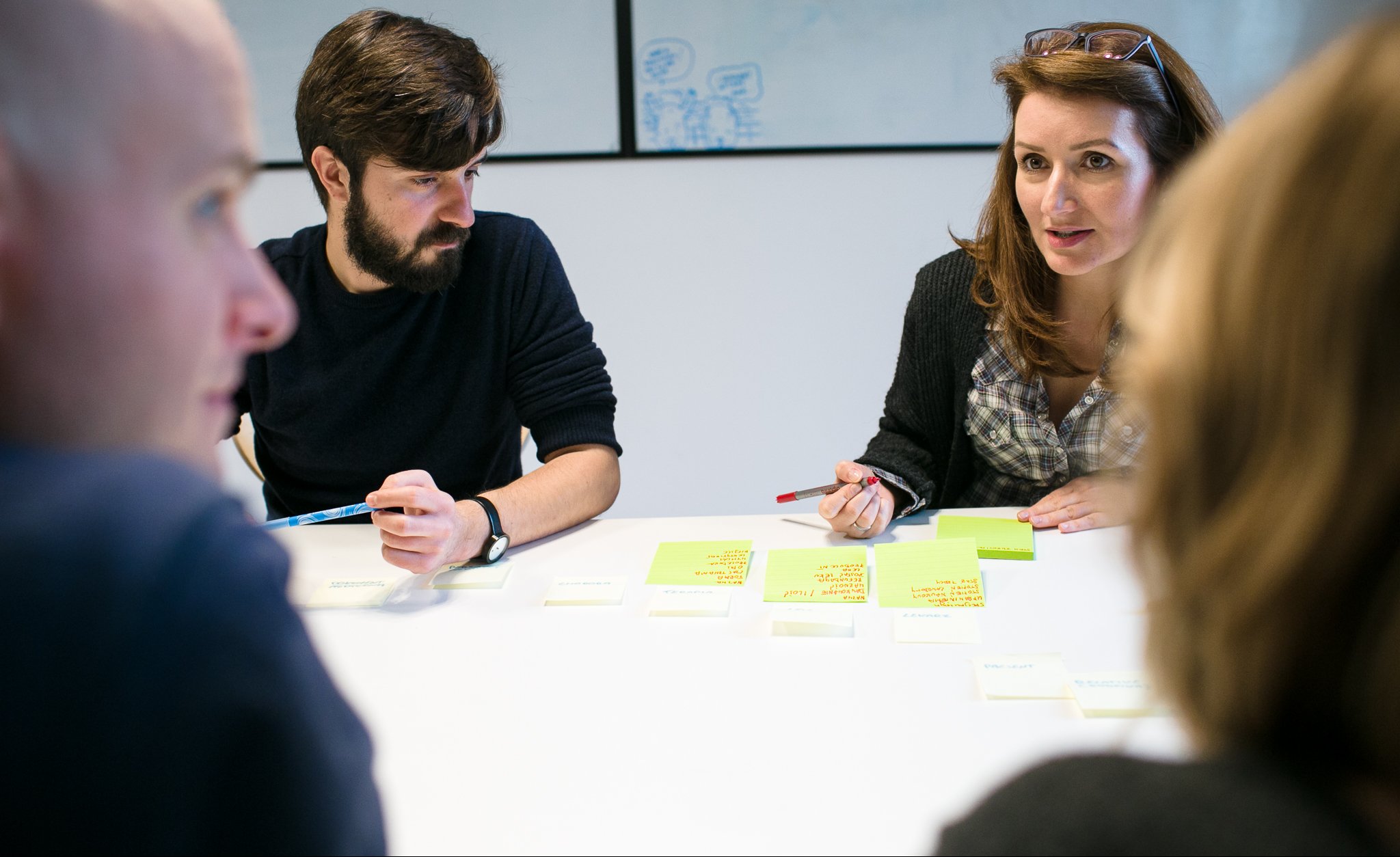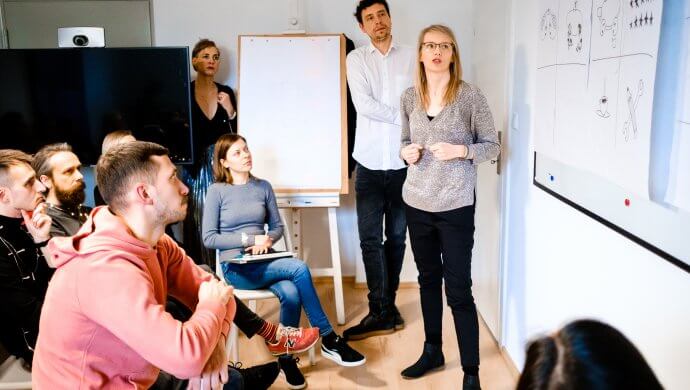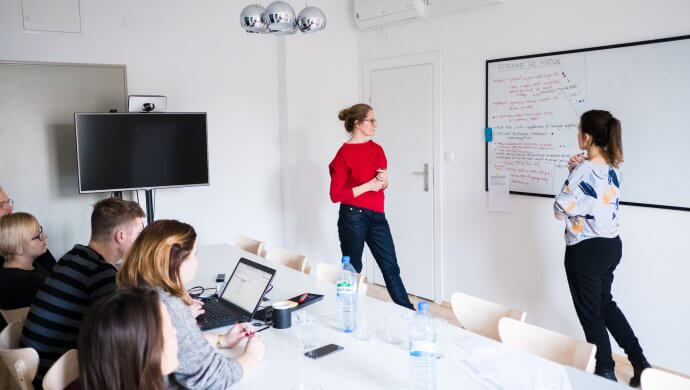It is difficult to find a large organisation that does not enjoy the benefits of an intranet. In the era of remote and hybrid working, employee communication platforms and collaboration and knowledge-sharing tools have become a critical part of the Digital Employee Experience (DEX).
For more than 10 years, we have researched and designed digital workplace tools for brands such as Glencore, TAURON, IMPEL, Rossmann, European Investment Fund, Roche, BNP Paribas, and Crédit Agricole, which has allowed us to gather a wealth of experience in their construction, development and optimal use, and helps us assess when and how it is worth building effective internal communication platforms, and when it is better to improve them and ensure proper maintenance.
Every intranet needs care and attention
The digital workplace is a key area in organisations that understand how important it is not only to be productive but also to communicate, to have the right culture of collaboration, and to have easy access to company tools and information anywhere, anytime.
The aging of the intranet – like any digital system, over time – is an inevitable phenomenon. Some of the causes are external and stem from technological changes, the introduction of new tools, failure to adapt to ever-changing design standards, or loss of compatibility with the company’s ecosystem of tools.
Internal causes are usually related to organisational changes (growth, divisions, acquisitions), changing user needs, or a lack of effective care for the development and creation of content, resulting in increasing disorder and outdated information available on the intranet.
IT tools are aging extremely fast and the expectations of a rapidly changing labour market are constantly posing new challenges to those responsible for looking after the Digital Employee Experience (DEX).
A very significant challenge is the discipline of editors – content without care and periodic review, becomes outdated, and the lack of attention to order and structure means that directories and categories become increasingly unstructured, making it difficult to get to the right information and eroding a comprehensible and structured information architecture.
Optimise or redesign?
Given the above, every organisation should periodically review the quality of its intranet platform, examining employee satisfaction, the timeliness of the content, or the technological quality of the solution (speed of operation, cyber security, etc.).
If there are indications of problems, it is necessary to take appropriate steps – these usually boil down to answering a fundamental question: optimise the current intranet or build it from scratch?
Optimisation is a common choice for many companies because of the smaller initial investment of time and energy. Very often, however, optimisation processes deeply interfere with the way the tool works and require major changes, plus, in the long term, they do not give the expected return on investment. Designing solutions from scratch is, of course, more time-consuming, but it also provides the necessary freedom to effectively address the needs of employees and the requirements of the business, and it allows you to pay off the technology dug and do a thorough clean-up of the content layer and information architecture.
To effectively answer the key question of the article, the following questions need to be considered and explored:
- When was the current intranet created?
- Does it work efficiently and quickly (how is this measured)?
- Is it used by employees? To what extent, and how often?
- Does it contain all the necessary and up-to-date content?
- Does it have an appropriate information architecture and access structure?
- Is it accessible on mobile devices?
- Does it adequately address all employees’ needs, especially after the changes following the pandemic of the year and the proliferation of remote and hybrid working?
- Have new processes emerged that are not supported on the current intranet in use?
- Have there been no recent acquisition processes and are there not several analogous intranet platforms in operation in the organisation?
If doubts arise when answering these questions and the implementation of the current system took place more than three years ago, there is probably a lot of room for improvement in the tool currently in use and, consequently, in the productivity of the organisation. In the following text, I provide more information and recommendations on important areas and good practices that will suggest how to design a useful and effective intranet or how to optimise the current system in use.
The design process takes time
The average time to design and implement a new intranet is between one and two years – according to the 2021 NNg report. This means that such extensive tools need a proper design process and effective management to ensure that the end result can be satisfactory for all stakeholders.

This time should also be taken into account when formulating expectations for when the new platform will be implemented – as this process requires in-depth analysis, design, implementation, testing, migration, and content creation and – often the most demanding and difficult – ensuring that the new tool is adopted and familiarised to all audiences.
The optimisation process, which is worth pursuing after proper UX research and in-depth interviews, will of course take much less time, but may not solve all the pain points. It is worth emphasising that optimisation should be an ongoing and iterative process to keep DEX in the organisation at a high level.
The following recommendations are based on the example of design processes we have conducted since 2010 for a number of large and international organisations with demanding structures.
Among other things, we had the pleasure of designing and helping to implement the prestigious Norman&Nielsen Group award-winning Intranet for Tauron! The decision to create a new system for several thousand recipients in over a dozen companies resulted from changing organisational challenges and the background to the group’s dynamic growth and a series of acquisitions. The system that resulted from this work is:

We are also currently working on the design and implementation of Glencore’s intranet – a global leader in sourcing. Glencore has 130,000 employees in 30 countries, spread across more than 130 different sites. After conducting surveys with employees on 4 continents, auditing the previous intranet, reviewing the information architecture, and assessing the level of user experience, we identified the challenges and needs of different audiences. Content editing was approached differently in specific departments and countries. Not in every location was the current intranet a real aid to their duties. The design of The Core (Glencore’s intranet) as well as our many years of experience in creating user-friendly and functional digital employee experiences show how complex and multi-faceted the intranet research and design process is.
In order to avoid mistakes and to carry out this process as optimally as possible, I have listed below some areas to consider when deciding whether to build a new tool or optimise it.
The issues listed below, if addressed in the design process, have a direct impact on increasing the effective communication and productivity of employees in the organisation.
1. How well the organisation is prepared for the demands of remote working. Remote work is work.
As many as 77% of potential Generation Z employees are more likely to respond to job adverts when there is an assurance of flexible working arrangements in the content. (according to 2022 Global Talent Trends). Interest in ‘flexible work’ issues increased by as much as +362% from 2019 to 2021 (2022 Global trends). This indicates the importance of a future employer’s ability to organise remote working in a dynamically changing HR environment. We need to accept this change, and in the context of an ever-evolving labour market, an employee-centered approach is becoming very important. An optimal digital working environment should ensure that employee can perform their duties easily and quickly from anywhere. It is necessary to diagnose and define procedures for two new forms of work provision (besides stationary work), namely hybrid work and remote work. In the context of DEX, it is necessary to take care of good communication, easy and responsive IT support, but also inclusiveness of the organisation.
Are the differences in working 100% remotely, hybrid, or on-premises analysed and taken into account in the organisation? Does the tool work appropriately on different devices including mobile? If the answer to these questions is no – a major overhaul of the current system should be considered.
2. Feedback from employees is hard to come by, especially if we do not regularly encourage them to be honest. The trap of the closed tool
In our private lives, we are very demanding when it comes to the quality of the digital solutions we use. Our personal preferences or tastes determine which online services we spend our money in. We are also relatively anonymous, so we like to give ratings to shops and services that have surprised us (positively or negatively).
If a service fails us we simply move somewhere else. Unfortunately, employees do not have this freedom and cannot change the intranet for a more intuitive one. Not everyone is willing to communicate their dissatisfaction willingly either. Constant, frank, and two-way communication can be very effective in helping to diagnose the problems employees are facing. It is worth checking when was the last time it was examined, and how do employees use the current intranet? Does everyone know how to report system malfunctions? Do such reports occur regularly? And does anyone analyse them? Have specific people been designated as responsible for keeping the content on the tool up to date?
If the answers here are “no”, there is certainly a lack of adequate knowledge of the difficulties in the operation of the tools currently in use. It is likely that some of the problems can be easily solved through optimisation. Others may suggest the need for a complete overhaul of the intranet. One inconvenience does not determine the quality of the platform, but if they accumulate over time, they lead to frustration for the team and reduce their productivity and morale.
How do you start a satisfaction survey? Many companies use internal surveys, which is a quick and relatively cheap way to gather relevant feedback. Consider conducting them anonymously and regularly and see how satisfaction levels change and what faults or annoyances are reported, and then plan optimisation activities. If, as a result of this, the results do not improve and serious difficulties in using the platform continue to be reported, it may be a good idea to start implementing a completely new tool.
3. Appropriate analytics
Easy to measure – hard to interpret. KPIs – the key performance indicators against which intranet usability is most often assessed are:
- Average daily views
- Average daily visitors
- Sessions per user
- Average time spent on the intranet
- Average daily views per daily visitor
- Number of messages and comments per user
Indicators and their change over time should always be analysed in the context of changes and events in the organisation. Average views, visits and percentage of users should of course increase, reflecting better adoption of the intranet, however, longer time spent on the platform is not always a good sign.
Specific, specific processes should be shortened by optimising the information architecture. It is important for the team responsible for the intranet to start collecting data as soon as possible and to start analysing indicators by examining desired trends and employee behaviour.
An examination of specific processes and an in-depth analysis of sensitive steps may be necessary here. The intranet team should constantly ask themselves: how do we measure success and what are the most important processes for the organisation? What content are employees looking for? What do they have problems with? Are they using all the modules and documents that are available? It is also worth examining the indicators by specific departments and locations and analysing the figures in the context of their function and position in the organisation (managers, specialists, external employees, production employees, business partners). With the right context and data collected, we can answer the question: are the observed levels and changes in KPIs positive?
In summary, in order to assess the quality of the intranet, it is crucial to regularly collect data on the traffic and adoption of the tool. These should then be analysed, preferably in the context of the survey results mentioned above.
If the problems are related to the quality of content and the hierarchy of information, the solution will probably be to organise and better control the publication of this information. Appointing specific people responsible for the structure and timeliness of each section or module may help. However, it is possible that the requirements or information needed in the process have changed and that our tools and content have not been updated accordingly. Maybe required information has emerged that we already publish elsewhere and can be easily made consistent and moved so as not to force the user to switch between tools. It is only through such a comprehensive analysis that a reasoned decision can be made to start the process of creating a new platform.
4. The crucial importance of information architecture.
If you are building a serious structure make sure you know how to prepare the foundations.
Over the past few decades, the knowledge of how to communicate effectively using digital tools has become well-established. Unsurprisingly, audiences are reading less and less, and the information above is read more often than the information below.

Digital tools have extensive menus where various functions and links to processes are placed. Searching for these in the menus takes time and if the information architecture has a design that does not reflect the needs of the employees, it will reduce productivity and the speed of finding them.
The process of creating an intuitive information architecture usually starts with collecting a list of needs (processes, functions, information) that the employee uses most often. This is followed by a card sorting study and prioritisation so that the most frequently used links are available at the top level of navigation, with key subcategories at the top of drop-down lists or tables of contents. Placing them in this way speeds up access and minimises the time and number of clicks required to reach the information sought. Different interests and needs sometimes arise, of course, when creating a navigation structure, depending on departments and positions in the organisation, but properly conducted research and sensibly applied personalisation make it possible to respond to this challenge.
There are many methods to effectively select and structure the right functions and tools. As mentioned, often used are Card Sorting and Tree Testing. In the process of developing an information architecture, it is worth conducting both qualitative and quantitative research. This is a key stage to avoid many mistakes in the future. Adequate research and, last but not least, appropriate interpretation of the research will help create solutions that are fit for purpose.
It is worth benefiting from the knowledge and experience of UX researchers. Many organisations successfully optimising digital working environments use workshops such as the Discovery Sprint. These are designed to, describe the Customer Journey Map and Persona and are the basis for understanding the different perspectives and needs of the system’s audience. This is essential knowledge for a good design and implementation of an intranet in a large organisation. An up-to-date list of the functions and processes supported by the intranet, prepared in this way, enables it to be compared with the needs of different groups of employees. If the analysis process has established that there are a lot of new functions and information that are not present on the intranet, but are important for the users, it is logical to consider designing a new tool from scratch.
5. Lack of individual approach or possibility to adapt the space to the employee’s needs.
Everyone likes to be treated individually.
An individual approach builds a relationship. We are more willing to use tools adapted to our needs, but, just as importantly, we use them faster and more efficiently. When it comes to personalising an intranet, different solutions are emerging – depending on the complexity of the organisation itself and the technical capabilities of the platform. Some companies build intranet homepages according to an employee’s affiliation to a particular organisational unit or location, or the initiatives and projects they are involved in. It is a good idea to include a place to configure your own links to external resources or to add the ability to plug in other tools or resources used within the company. To increase productivity, emails are downloaded and team chats appear to allow quick and easy communication. It is also useful to be able to add any function or link in the system to favourites and create your own folders and groups. It is a good idea to tag the people in your organisation who are responsible for handling the relevant sections of the intranet so that you can easily report page malfunctions or non-functioning features to the appropriate people.

Personalisation of notifications, i.e. their scopes (topics, groups) and forms (@, texts, desktop popups), is also valuable.
In recent times, Covid 19 threat communication or crisis communication in general has also become extremely important.
Whether the tool needs to be redesigned depends on the current customisation possibilities and available versions of the intranet. Even the smallest organisations have different departments and needs, so it is necessary to prepare several scenarios for the use of our tool.
The lack of a customised approach certainly reduces its usability and therefore productivity.
6. Non-functional or ineffective search engine.
If you allow searching then help finding.
Recipients often abandon the purchase of a product or service simply because they do not find what they are looking for after the first search or the presentation of the results is inadequate and unreadable. On an intranet, search plays a fundamental role. It is therefore important that the search engine works very effectively. This means that the scope of the search should include different types of content and locations, but also that the search engine should be able to find different types of wording and take context into account. Sometimes it may be necessary to standardise the tags next to the content entered into an organisation in order to get the most out of the search. Hints with recently opened documents also work well.
The best search engines are optimised continuously as the organisation is constantly generating new documents and entries. Testing and improving search engine performance is one of the most effective methods (along with information architecture controls) to reclaim time irretrievably wasted by employees on repetitive tasks in their daily work.
7. DE&I – diversity & inclusion.
Diversity and equal treatment are the responsibility of every organisation.
Respecting and accommodating diversity (diversity & inclusion management) is not only a global standard but also a testament to the maturity and responsibility of large organisations. Every responsible global institution is already considering DE&I issues. As EDISONDA, we have extensive experience in implementing complex forms of reporting and controlling such processes. Together with Grant Thornton’s UK division, we have designed solutions to measure and manage an organisation’s diversity and inclusivity consideration strategy. The application consists of a survey section, allowing anonymous assessment by employees, and a panel for managers, presenting the results to their own organisation. It is the responsibility of every organisation to effectively explore, analyse and proactively respond to issues of inclusivity and diversity. In the context of digital tools, the employee’s perception capabilities should be taken into account, especially if the company is international. Translations of content should be standard, and there should also be a check on the inclusiveness of the content, and the appropriate language (this includes the aspect of so-called readability). Accessibility is also an important issue. With the right approach, a large proportion of potential changes for inclusiveness can be carried out as part of optimisation and, except in extreme cases, will not necessitate the redesign of the intranet. 8.
8. Maintain constant contact with stakeholders.
In such a team, we will not miss anything important.
Optimising an organisation’s digital tool requires extensive consultation. The formation of an interdisciplinary team will reduce the risk of lack of adoption and adequately respond to all staff needs. A UX designer, UI designer, developer, lawyer, sales, marketing, accounting, production, and customer service representatives should certainly not be absent.
The whole of such process is usually overseen by a product owner or manager who manages the internal communication team. Ultimately, representatives from every department in the company should participate in the team, along with specialists responsible for research, design, and implementation. In our experience, many organisations may lack appropriate specialists in UX research and design. This is therefore a field for intranet optimisation considerations. As experienced specialists in the design of usable digital solutions, we understand the importance of our participation at every stage of the work.
If the intranet team lacks User Experience specialists, it is very likely that even with a thorough knowledge of the employees’ problems, it will not be possible to solve them adequately. In addition, maintaining the usability of digital tools at the highest level requires up-to-date knowledge and a large dose of understanding of the interests of all parties. Above all, however, a UX specialist will ensure that any solution designed is intuitive, usable, and necessary, thus improving the satisfaction and ease of use of the intranet.
9. When you hand over, promote and ask for feedback.
We take pride in what we do, but your opinion is always paramount.
Whether we are introducing entirely new tools or merely optimising existing ones, we often encounter resistance or reluctance from employees before making changes. Even if the needs have been properly researched and the changes being made realistically solve their problems, the recipients need time and justification if they are to accept the changes being made.
As UX specialists, we understand that this ‘fear of change’ is an unavoidable part of the process and should be influenced by appropriate change management tools. It is good practice to ask again the people surveyed in the needs identification process how they evaluate the implemented tools and changes. Along with implementation, appropriate promotional materials describing the benefits of the new solution should be planned. It is best if these are created for specific company departments, as changes affect them differently. Short instructional videos describing the positive changes and new features can be helpful. If the change has been extensive, many institutions also organise user training sessions dedicated to specific teams or organisational units. Such meetings will help to teach how to use the new tool, but also to learn about the most common mistakes so that they can be clearly mentioned in subsequent messages promoting the new tools. It is also important not to forget the easy way of reporting errors and comments. It is also valuable to appoint ambassadors for the new solutions within the company, as new (even better) solutions require adequate social proof of rightness.
In summary, in order to properly influence the employee experience within the digital workplace, it is important to know their needs as well as to understand the dynamically changing standards of remote working. If the digital tools used in an organisation are not regularly tested and their introduction took place more than three years ago they probably need at least a thorough optimisation or the start of a new version-building process.
The question of where the fine line between optimisation and redesign runs is difficult to answer unequivocally. Research into the needs of users and the usability of the digital tools used is key. The results of this research will not only allow us to better assess design needs but will certainly also prove valuable to HR departments in terms of evaluating satisfaction with digital tools. Based on the research, we can create a list of needs, problems, and potential solutions. The key here is also to link the needs of employees to the vision and direction of the organisation.
All considerations about usability and taking a user’s perspective should be assessed through the lens of productivity and overall satisfaction with the available digital tools and processes in the organisation. The core value of any company is its people and their expectations – especially of employees coming from the younger generations – are very exacting, the role of internal communications departments in maintaining a high level of DEX is to constantly improve the quality of digital tools.
Feel free to contact us – we would be happy to talk about optimising or building digital workplace tools.






